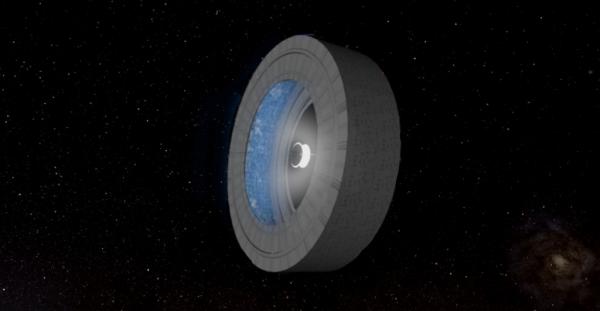BY LETTER
Bishop Ring
Technology > Technology Type or Material > Drytech/Hylotech
Technology > Technology Levels > High Tech / Hitech
Technology > Application > Infrastructure
Technology > Application > Megascale Engineering
Technology > Technology Type or Material > Nanotech
Technology > Technology Levels > High Tech / Hitech
Technology > Application > Infrastructure
Technology > Application > Megascale Engineering
Technology > Technology Type or Material > Nanotech
 Image from Arik | |
| Bishop ring interior | |
Giant rotating orbital habitat, built of woven diamondoid/buckyfibre cable; these come in a range of sizes up to 2000 km in diameter and 500 km deep. The atmosphere is mostly retained by the centrifugal force of the spinning habitat, but to reduce losses further, most rings have a thin transparent membrane that seals the opening..
In the Information Age Forrest Bishop proposed this design of ring-shaped, open ended habitat, with the atmosphere retained by centrifugal force and tall atmosphere walls.
When carbon nanotube buckyfibre cable became readily available through nanofacturing techniques, the size of rotating habitats could be increased considerably. The largest rotating habitats possible using this material can be slightly more than one thousand kilometers in radius, depending on the mass of landscape included. Most rings are somewhat smaller than this for safety reasons.
Image from Steve Bowers | |
| Rendell Bishop Ring | |
The ring is constructed from a coil or weave of carbon nanotube buckytube, formed into a short cylinder which is rotated to produce artificial gravity. Carbon Nanotube is sufficiently strong to support a cylinder of around 2000km in diameter with a rotation producing 1 gravity, but this leaves little margin for safety, and does not allow for the mass of the artificial landscape inside the ring. So most rings with Earth-like gravity are significantly smaller, from a few hundred up to a thousand kilometres in diameter. However a significant number of rings rotate more slowly, producing a lower gravity regime (a condition which is often popular with the inhabitants). The Arkab B necklace, for example, consist mostly of rings around 2000km across and an internal gravity of 0.8 gees or less.
This coil, or weave, is used to reinforce the main bulk of the ring, which holds atmosphere, soil, water, rocky substrate and habitations. In most versions of the Bishop Ring design, the bulk of the atmosphere is retained by a tall atmosphere wall ranging in height from 50km to 200km. Even 200km high walls are not high enough to prevent gradual atmosphere loss, so a thin transparent membrane or an airwall is used to cut atmospheric escape to negligible levels.
 Image from Steve Bowers | |
| Koyukon 3, a bishop ring in the Terran Federation. Bishop rings are used in many polities, and variation in their design details is commonplace | |
 Image from Steve Bowers | |
| Ayen Jin bishop ring in the Iota Piscium system is brightly decorated inside and out, in accordance with the exuberant style of that polity | |
 Image from Steve Bowers | |
| Bishop Ring Dennet, a ring in the Negentropy alliance | |
Related Articles
- Banks' Orbital
- Bernal Sphere
- Luminaire
- McKendree Cylinder
- O'Neill Cylinder
- Orbital (habitat)
- Orbital (political unit) - Text by M. Alan Kazlev
Originally, a nation state or city state based on habitats in orbit around Old Earth. Over the course of the Interplanetary Age the term came to be used for any such state in Solsys. By early First Federation times the term Orbital was used more broadly for any independent or semi-independent state based on a hab in orbit around a planet. - Rotating Space Habitats
- Stanford Torus
Appears in Topics
Development Notes
Text by M. Alan Kazlev, Todd Drashner and Steve Bowers
Initially published on 08 October 2001.
Initially published on 08 October 2001.
Additional Information
Forrest Bishop's original article here
http://www.iase.cc/openair.htm
Wikipedia Article
Bishop Rings
http://www.iase.cc/openair.htm
Wikipedia Article
Bishop Rings






